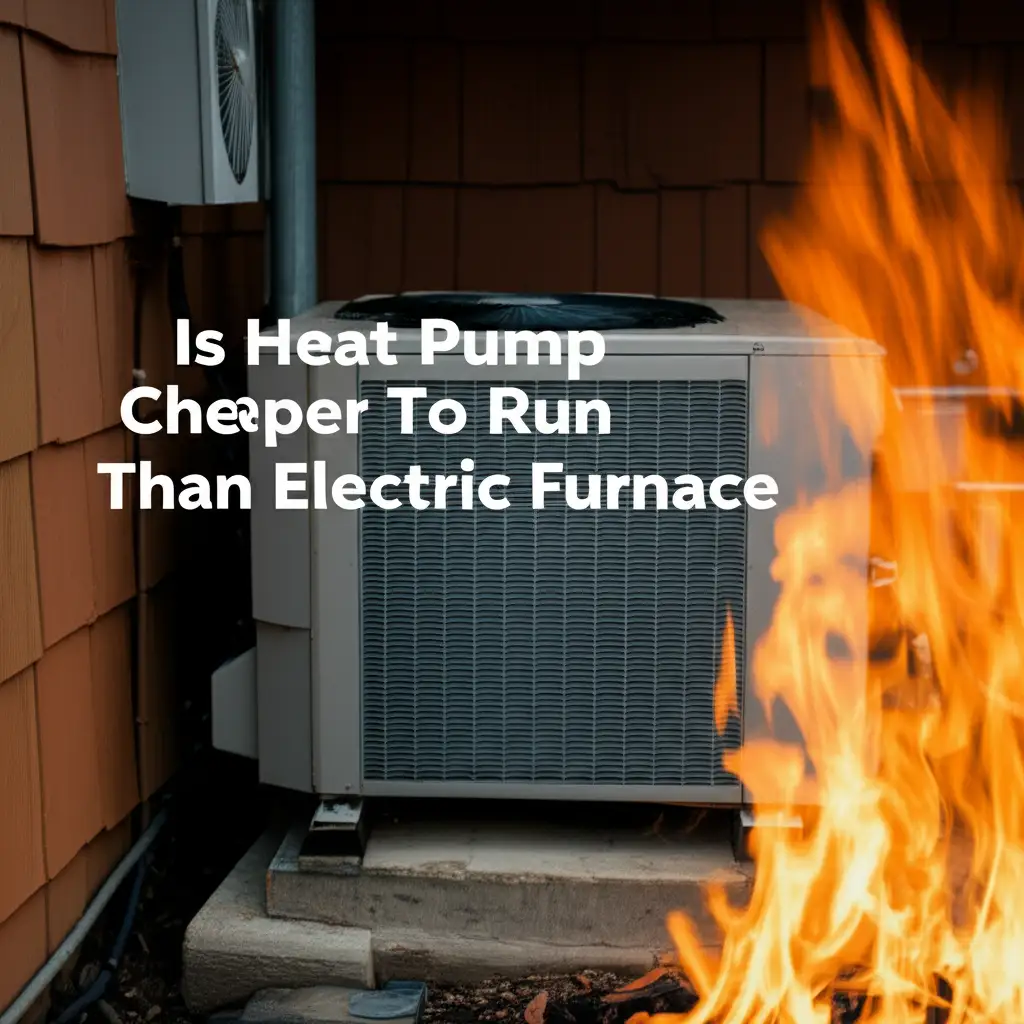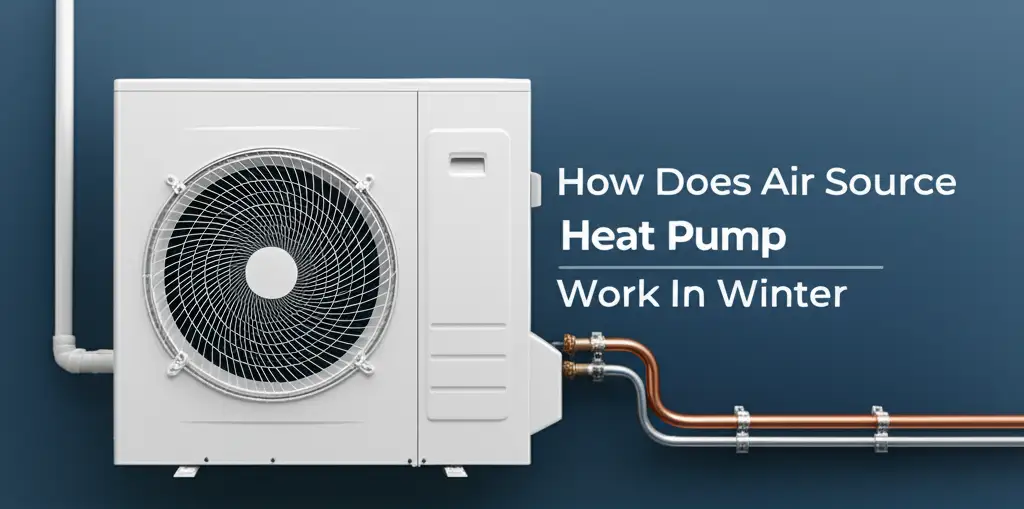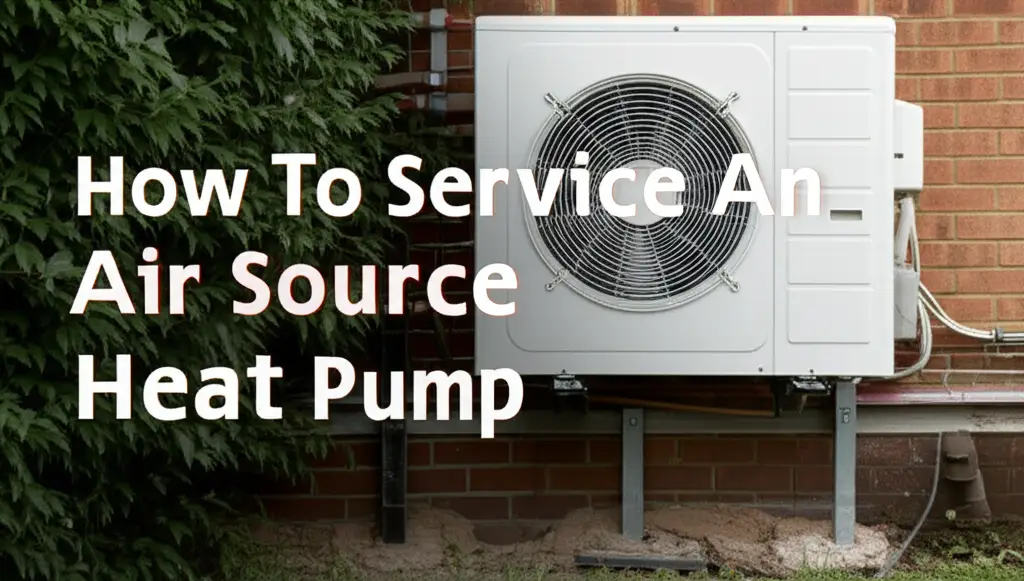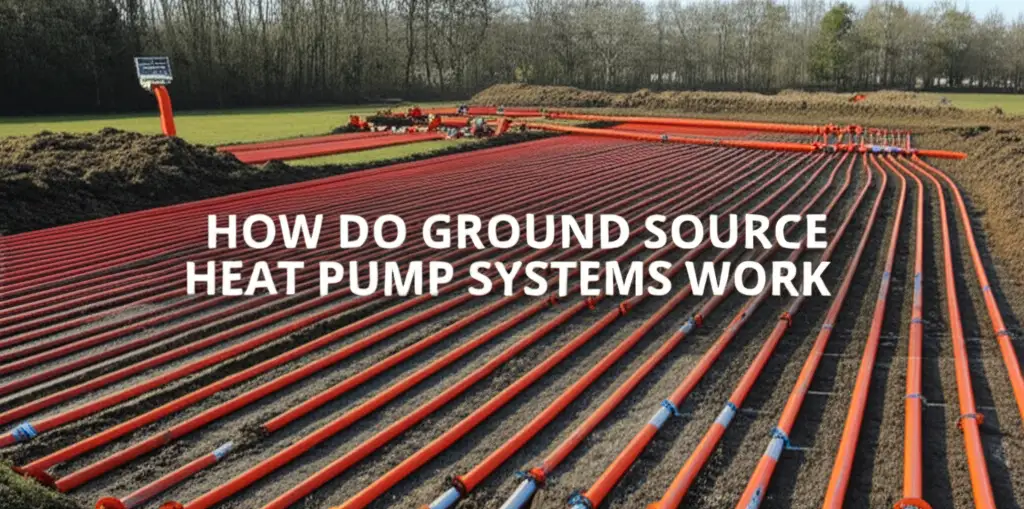· Katria Melrose · Home Heating · 20 min read
Is Heat Pump Cheaper To Run Than Electric Furnace

Heat Pump Cheaper to Run Than Electric Furnace? The Truth
Heating your home efficiently is a big concern for many homeowners. You want comfort without breaking the bank. People often ask: Is a heat pump cheaper to run than an electric furnace? This is a key question for anyone considering a new heating system. Understanding the differences can save you significant money on utility bills.
Both heat pumps and electric furnaces use electricity. However, they use it in very different ways to create heat. This difference directly impacts their operational costs. We will explore how each system works. We will compare their energy efficiency, installation costs, and long-term savings. This article provides a clear picture to help you make an informed decision for your home heating needs.
Takeaway
- Heat pumps generally operate at a much lower cost than electric furnaces due to their high energy efficiency.
- Electric furnaces convert all electricity into heat, resulting in 100% efficiency but higher running costs.
- Heat pumps transfer heat, making them 200-400% more efficient than electric furnaces in mild to moderate climates.
- Upfront costs for heat pumps are typically higher, but government incentives can offset these expenses.
- Climate plays a significant role; colder regions may require a heat pump with supplementary heat, impacting costs.
A heat pump is almost always cheaper to run than an electric furnace. This is because a heat pump moves existing heat rather than generating it from electricity. This process makes it far more energy-efficient. It uses less electricity to deliver the same amount of warmth to your home.
Understanding How Heat Pumps and Electric Furnaces Work
Before we compare costs, let us understand how these two heating systems operate. Both systems rely on electricity. However, their methods of heat production are very different. This core difference explains the significant variations in their running costs. Knowing the mechanics helps you see where efficiency gains occur.
How an Electric Furnace Heats Your Home
An electric furnace is a straightforward heating appliance. It works much like a large electric toaster or a hair dryer. Inside the furnace, electric resistance coils heat up when electricity passes through them. A fan then blows air over these hot coils. This warmed air moves through your home’s ductwork. The system then distributes this heated air into different rooms.
Electric furnaces are simple in design and operation. They are 100% efficient at converting electricity into heat. This means every unit of electricity you pay for becomes heat in your home. However, electricity is a relatively expensive form of energy. Converting it directly into heat can lead to high utility bills. There are no energy losses during the conversion process itself. The high cost comes from the price of electricity per unit.
How a Heat Pump Heats and Cools Your Home
A heat pump operates differently from an electric furnace. It does not generate heat by burning fuel or using resistance coils. Instead, a heat pump moves heat from one place to another. In winter, it extracts heat from the outside air, even cold air. It then transfers this heat inside your home. In summer, the process reverses. The heat pump moves heat from inside your home to the outside. This dual capability means one system handles both heating and cooling needs.
Heat pumps use a refrigerant and a compressor to absorb and release heat. This process is very efficient. For every unit of electricity a heat pump consumes, it can deliver two to four units of heat. This efficiency is why they are often much cheaper to run than electric furnaces. They are simply moving existing heat, which requires less energy than creating new heat. This operational principle is a major advantage for reducing energy consumption and costs.
Energy Efficiency: The Core Difference in Running Costs
The biggest factor in how much your heating system costs to run is its energy efficiency. This is where heat pumps truly shine when compared to electric furnaces. The fundamental way each system produces or transfers heat directly impacts its efficiency rating and, therefore, your monthly energy bill. Understanding these efficiency metrics is vital for comparing the true operational costs.
The Efficiency of Electric Furnaces
Electric furnaces are often described as having 100% efficiency. This statement is technically true for how they convert electricity into heat. All the electrical energy consumed is transformed into thermal energy for your home. There is no waste in the conversion process itself. For example, if you pay for 1 kilowatt-hour (kWh) of electricity, you get 1 kWh of heat. This sounds very good on paper.
However, the high efficiency rating does not mean cheap operation. Electricity itself is an expensive energy source compared to natural gas or even the “free” ambient heat a heat pump uses. So, while an electric furnace efficiently converts costly energy, it still uses a lot of that costly energy. This results in higher running costs compared to a heat pump. The cost per unit of heat delivered is high because the input energy is high-priced.
The Efficiency of Heat Pumps
Heat pumps are significantly more efficient than electric furnaces. They achieve this efficiency because they do not create heat. Instead, they transfer heat. This means they use a small amount of electricity to move a large amount of thermal energy. For example, a heat pump might use 1 kWh of electricity to move 3-4 kWh of heat into your home. This is why their efficiency ratings can exceed 100%.
Heat pump efficiency is measured by different metrics:
- SEER (Seasonal Energy Efficiency Ratio): Measures cooling efficiency. Higher SEER means better efficiency during cooling.
- HSPF (Heating Seasonal Performance Factor): Measures heating efficiency. Higher HSPF means better efficiency during heating.
- COP (Coefficient of Performance): A direct measure of heating efficiency at a specific temperature. A COP of 3.0 means for every unit of electricity consumed, 3 units of heat are delivered.
Modern heat pumps often have COPs ranging from 2.5 to 4.5. This means they are 250% to 450% more efficient than electric resistance heating. This superior efficiency translates directly into lower electricity consumption for the same amount of heat. Consequently, your heating bills will be substantially lower with a heat pump. This makes a strong case for why a heat pump is cheaper to run than an electric furnace. You can learn more about heat pump operation by understanding does an air source heat pump run all the time to maintain consistent temperatures.
Comparing Operating Costs: Real-World Scenarios
To truly understand which system is cheaper, we must look at real-world operating costs. These costs are influenced by several factors. The main factors are your local electricity rates and the climate where you live. Heat pumps generally offer significant savings. However, the exact amount can vary. Let’s break down how these elements affect your heating bill.
Impact of Electricity Rates
Electricity rates vary widely across different regions. Some states or utility providers have much higher electricity costs per kilowatt-hour (kWh) than others. This rate directly impacts how much you pay for heating. If your electricity rate is high, the cost difference between an electric furnace and a heat pump becomes even more pronounced. A heat pump’s superior efficiency means it uses fewer kWh to produce the same heat. This reduces the total cost significantly.
Let us consider an example. Imagine your home needs 10,000 BTUs of heat per hour.
- An electric furnace, at 100% efficiency, would need about 2.93 kWh to produce 10,000 BTUs.
- A heat pump, with a COP of 3.0 (meaning 300% efficiency), would only need about 0.98 kWh to produce 10,000 BTUs.
If your electricity costs $0.15 per kWh:
- Electric furnace: 2.93 kWh * $0.15/kWh = $0.44 per hour
- Heat pump: 0.98 kWh * $0.15/kWh = $0.15 per hour
Over a month or a heating season, these small hourly savings add up to substantial differences. This calculation clearly shows that a heat pump is cheaper to run than an electric furnace under typical conditions. If you find your heat pump bills higher than expected, you might investigate why is my air source heat pump expensive to run. Similarly, if you have a ground source system, specific factors can make it costly, such as found in why is my ground source heat pump so expensive to run.
Climate and Performance
The performance and efficiency of a heat pump are influenced by outdoor temperatures. Heat pumps extract heat from the outside air. As temperatures drop very low, there is less heat available to extract. This means the heat pump must work harder. Its efficiency (COP) decreases at lower temperatures. In extremely cold climates, a standard air-source heat pump might struggle to provide enough heat on its own.
Modern cold-climate heat pumps are designed to operate efficiently even in freezing temperatures (down to -15°F or even lower). However, if temperatures drop below the heat pump’s optimal operating range, it may rely on a supplementary heat source. This supplementary heat is often electric resistance coils, similar to those in an electric furnace. When the heat pump activates its auxiliary heat, running costs will increase. This temporary reliance on electric resistance can affect your overall energy bill. Understanding does heat pump shut off when auxiliary heat is on helps manage expectations for very cold days. For homes in mild to moderate climates, a heat pump will consistently be the more economical choice. In extremely cold regions, a well-sized cold-climate heat pump or a hybrid system (heat pump plus furnace) might be the best option.
Beyond Running Costs: Upfront Investment and Installation
When comparing heating systems, it is important to look beyond just the monthly utility bills. The initial investment, including the purchase price and installation costs, plays a big role in the total cost of ownership. While a heat pump is cheaper to run than an electric furnace, its upfront cost is typically higher. This difference in initial investment is a critical factor for many homeowners.
Heat Pump Installation Costs
The initial cost of purchasing and installing a heat pump system is generally higher than for an electric furnace. Heat pumps are more complex systems. They include an outdoor unit (compressor and coil) and an indoor unit (air handler). The installation often requires more specialized labor. It may involve installing refrigerant lines and updating electrical wiring. The total cost for a heat pump can range from $4,000 to $12,000 or more. This price depends on the system type (air source, ground source), size, brand, and local labor rates. Ground source heat pumps are even more expensive to install due to the excavation required. This initial hurdle can make some homeowners hesitate.
However, it is crucial to consider the long-term savings. The higher upfront cost of a heat pump is often offset by its significantly lower operating costs over its lifespan. These savings can lead to a quicker payback period. Additionally, many governments and utility companies offer rebates and tax credits. These incentives can substantially reduce the effective installation cost. This makes the heat pump a more attractive investment.
Electric Furnace Installation Costs
Electric furnaces have a lower upfront cost compared to heat pumps. They are simpler systems. Their installation process is generally less complex and time-consuming. The average cost for an electric furnace, including installation, typically ranges from $2,000 to $7,000. This makes them a more budget-friendly option for initial purchase. If you are replacing an existing electric furnace, the installation might be even simpler. This is especially true if the ductwork and electrical connections are already in place.
While the initial cost is lower, remember that the long-term running costs are higher. Over the lifetime of the unit, an electric furnace will likely cost you more in electricity bills than a heat pump. So, while it seems cheaper at first, the total cost of ownership often favors the heat pump. You should weigh the immediate savings against the recurring expenses.
Maintenance, Lifespan, and Long-Term Value
When evaluating if a heat pump is cheaper to run than an electric furnace, consider more than just energy efficiency and upfront costs. Ongoing maintenance needs and the expected lifespan of each system also impact the total cost of ownership. Proper maintenance can extend the life of your system and keep it running efficiently. Neglecting maintenance can lead to higher running costs and premature system failure.
Routine Maintenance for Both Systems
Both heat pumps and electric furnaces require regular maintenance to operate effectively and efficiently. Neglecting maintenance can lead to decreased performance and higher energy bills.
For an electric furnace, maintenance is relatively straightforward:
- Filter Replacement: The most common task is regularly replacing or cleaning the air filter. A dirty filter restricts airflow, making the furnace work harder. You can learn how to clean furnace filter to keep your system efficient.
- Annual Inspection: An HVAC professional should inspect the electrical connections, heating elements, and blower motor annually. This ensures safe and efficient operation.
- Ductwork Checks: Inspecting ducts for leaks ensures heat is not escaping before reaching your living space.
Heat pumps require slightly more involved maintenance due to their dual function (heating and cooling) and outdoor unit:
- Filter Replacement: Like furnaces, regular air filter checks and changes are crucial.
- Coil Cleaning: The indoor and outdoor coils can accumulate dirt and debris, reducing efficiency. Cleaning the outdoor coil is especially important, as it is exposed to the elements. Here is how to perform how to clean heat pump coils.
- Refrigerant Level Checks: A professional needs to check refrigerant levels. Low refrigerant can drastically reduce efficiency.
- Fan and Motor Inspections: Ensure the fan blades are clean and the motor runs smoothly.
- Annual Professional Tune-up: A comprehensive annual service by an HVAC technician is highly recommended. This includes checking electrical components, refrigerant, and overall system performance.
While heat pumps may have a few more maintenance points due to their complexity, these tasks are standard for any HVAC system that provides both heating and cooling. The minor additional maintenance cost is usually outweighed by the energy savings.
Expected Lifespan and Reliability
The lifespan of a heating system affects its long-term value. A system that lasts longer will spread its initial cost over more years, potentially reducing its annual effective cost.
Electric Furnaces: These systems are known for their durability and long lifespan. Because they have fewer moving parts than a heat pump, there is less to break down. An electric furnace typically lasts 15 to 20 years, or even longer, with proper maintenance. Their simplicity contributes to their reliability and longevity.
Heat Pumps: Heat pumps generally have a lifespan comparable to or slightly shorter than electric furnaces. Most heat pumps are designed to last between 10 and 15 years. Some high-quality models can last up to 20 years. The outdoor unit, exposed to varying weather conditions, can sometimes wear out faster. Consistent maintenance is vital for a heat pump to reach its full expected lifespan. A well-maintained heat pump will provide reliable and efficient service for many years.
Even with a slightly shorter average lifespan, the significant energy savings of a heat pump usually make it the more cost-effective choice over its lifetime. The money saved on monthly utility bills often exceeds the cost difference in lifespan or maintenance. This reinforces that a heat pump is cheaper to run than an electric furnace over the long haul.
Government Incentives and Rebates for Heat Pumps
One of the biggest factors that can tip the financial scales in favor of heat pumps is the availability of government incentives and rebates. These programs aim to encourage homeowners to adopt more energy-efficient technologies. They can significantly offset the higher upfront cost of a heat pump. This makes the initial investment much more manageable.
Various levels of government, from federal to state and local, offer these incentives. Utility companies also often provide their own rebate programs. These programs recognize the environmental and energy benefits of heat pumps. They help reduce the financial barrier for homeowners.
Here are common types of incentives:
- Federal Tax Credits: The U.S. federal government, through the Inflation Reduction Act (IRA), offers tax credits for eligible energy-efficient home improvements. This includes installing new high-efficiency heat pumps. Homeowners can receive a tax credit for a percentage of the installation cost, up to a certain limit. These credits directly reduce the amount of income tax you owe.
- State and Local Rebates: Many states, counties, and cities have their own programs. These might offer direct rebates or grants for installing heat pumps. These programs vary widely by location. You should check what is available in your specific area.
- Utility Company Rebates: Local electricity and gas providers often offer rebates to customers who upgrade to energy-efficient heating and cooling systems. These rebates encourage reduced energy consumption, which benefits the utility by lowering demand. You can find information on their websites or by contacting their customer service.
These incentives can reduce the net cost of a heat pump by hundreds or even thousands of dollars. This dramatically shortens the payback period for the higher initial investment. For example, a $2,000 federal tax credit and a $1,000 utility rebate could turn a $7,000 heat pump installation into a $4,000 net cost. This brings the effective cost closer to, or even below, that of an electric furnace.
Before purchasing a heat pump, research available incentives. Consult with your HVAC contractor. They often have knowledge of local programs and can help you navigate the application process. Taking advantage of these programs is a smart financial move. It makes the decision to choose a heat pump even more economically sound. It strengthens the argument that a heat pump is cheaper to run than an electric furnace when considering the total cost of ownership. It also allows you to explore options like can I run an air source heat pump with solar panels for further savings.
When an Electric Furnace Might Be a Better Fit (Or Not)
While the evidence generally points to heat pumps being cheaper to run, there are specific situations where an electric furnace might be considered. It is important to understand these scenarios. This helps ensure you choose the best heating system for your unique circumstances. Most of these situations relate to very specific climate conditions or very short-term needs.
One scenario is for homes in extremely cold climates that do not have access to natural gas. In areas where temperatures consistently drop far below freezing for extended periods, a standard air-source heat pump might struggle to maintain efficiency. While cold-climate heat pumps exist, they still may be less efficient in extreme cold than a direct electric resistance unit. For homes in such harsh environments, especially if the heating load is small, an electric furnace could provide consistent warmth without the efficiency drop seen in standard heat pumps. However, this comes at the cost of higher operating expenses.
Another situation might be a small, rarely used cabin or vacation home. If the heating system is only needed for very short periods, the high upfront cost of a heat pump might not be justifiable. In such cases, the lower initial investment of an electric furnace could make more sense, even with its higher running costs per hour. The total hours of operation would be minimal, so the difference in running costs would not accumulate significantly.
Finally, an electric furnace might serve as a backup or supplementary heat source for a heat pump. This combination is known as a dual-fuel or hybrid system. This setup offers the best of both worlds. The heat pump handles most of the heating efficiently. The electric furnace kicks in only during the coldest days, or if the heat pump needs repair. This ensures comfort while keeping overall costs down.
Supplemental Heat: When Heat Pumps Use Electric Resistance
It is crucial to understand that many air-source heat pumps include electric resistance coils as a supplemental heat source. These coils function exactly like an electric furnace. They turn on when the outdoor temperature drops too low for the heat pump to operate efficiently on its own. They also activate during defrost cycles or when the thermostat calls for a rapid increase in temperature.
When these auxiliary heat strips engage, your heat pump system is temporarily operating like an electric furnace. This means its energy consumption and running costs will increase during these periods. This is a primary reason why heat pump bills can be higher in very cold weather. The heat pump tries its best to move heat, but the electric strips provide the “boost” when needed.
Modern cold-climate heat pumps are designed to minimize the use of auxiliary heat. They can extract heat from much lower temperatures than older models. This reduces reliance on expensive electric resistance. If you live in an area with prolonged freezing temperatures, researching cold-climate specific heat pump models is essential. They will maintain higher efficiency and reduce the need for supplemental heat, reinforcing that a heat pump is cheaper to run than an electric furnace even in chillier conditions.
Frequently Asked Questions
Understanding the nuances of heat pumps versus electric furnaces involves answering common questions. These questions often relate to performance, maintenance, and long-term financial implications.
How cold can it be for a heat pump to work efficiently?
Modern air-source heat pumps are highly efficient down to 0°F (-18°C). Many cold-climate models can operate effectively at temperatures as low as -15°F (-26°C) or even lower. Below these temperatures, their efficiency decreases, and they may rely on supplemental electric resistance heat.
Do heat pumps require more maintenance than electric furnaces?
Heat pumps generally require slightly more detailed maintenance than electric furnaces. This is because they have both an indoor and an outdoor unit and manage both heating and cooling. Regular tasks include cleaning coils, checking refrigerant levels, and replacing filters. Electric furnaces mainly require filter changes and annual checks.
Are there tax credits for installing heat pumps?
Yes, in the U.S., federal tax credits are available under the Inflation Reduction Act for installing eligible high-efficiency heat pumps. Many states, local governments, and utility companies also offer additional rebates and incentives. These can significantly reduce the upfront cost of a heat pump.
Can a heat pump replace my existing electric furnace?
Yes, a heat pump can directly replace an existing electric furnace in most homes. Both systems use existing ductwork to distribute air. This makes the conversion relatively straightforward for a qualified HVAC professional. It is often a popular upgrade for energy savings.
What is the typical lifespan of a heat pump vs. an electric furnace?
An electric furnace typically lasts 15 to 20 years or more due to its simpler design. Heat pumps have a lifespan of 10 to 15 years on average, with some models lasting up to 20 years. Proper regular maintenance is crucial for maximizing the lifespan of both systems.
How much can I save with a heat pump over an electric furnace?
Savings vary based on electricity rates, climate, and system efficiency. However, a heat pump can typically reduce your heating costs by 30% to 70% compared to an electric furnace. Over the lifespan of the unit, these savings can amount to thousands of dollars, making a heat pump a far more cost-effective solution.
Conclusion
When considering heating your home, the question of “Is a heat pump cheaper to run than an electric furnace?” has a clear answer. For most homeowners, a heat pump offers significant long-term savings compared to an electric furnace. This is primarily due to its superior energy efficiency. Heat pumps move heat rather than generate it, using far less electricity to achieve the same level of comfort.
While a heat pump typically has a higher upfront installation cost, this initial investment is often quickly recouped through lower monthly utility bills. Furthermore, the availability of federal, state, and local incentives, as well as utility rebates, can substantially reduce the effective purchase price of a heat pump, making it an even more attractive financial choice.
Ultimately, choosing between a heat pump and an electric furnace involves weighing initial costs against long-term operational savings. For those prioritizing energy efficiency, lower utility bills, and environmental benefits, a heat pump is the clear winner. Consider your local climate, electricity rates, and available incentives. Then, consult with a qualified HVAC professional to determine the best heating solution for your home. Make the smart move for your comfort and your wallet.





